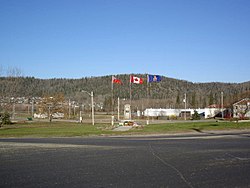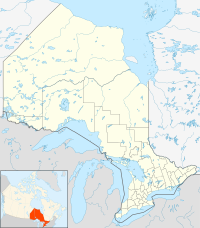Manitouwadge is a township in the Canadian province of Ontario. It is located in the Thunder Bay District, at the north end of Highway 614, 331 kilometres (206 mi) east of Thunder Bay and 378 kilometres (235 mi) north-west of Sault Ste. Marie.
Manitouwadge | |
|---|---|
| Township of Manitouwadge | |
 | |
| Coordinates: 49°08′N 85°50′W / 49.133°N 85.833°W | |
| Country | Canada |
| Province | Ontario |
| District | Thunder Bay |
| Settled | after 1953 |
| Incorporated | 1975 |
| Government | |
| • Type | Township |
| • Mayor | Jim Moffat [1] |
| • Federal riding | Thunder Bay-Superior North |
| • Provincial riding | Algoma—Manitoulin |
| Area | |
| • Land | 352.07 km2 (135.93 sq mi) |
| Elevation | 332.20 m (1,089.90 ft) |
| Population (2016)[2] | |
• Total | 1,937 |
| • Density | 5.5/km2 (14/sq mi) |
| Time zone | UTC-5 (EST) |
| • Summer (DST) | UTC-4 (EDT) |
| Postal Code | P0T 2C0 |
| Area code | 807 (826 exchange) |
| Website | www.manitouwadge.ca |
History
editManitouwadge (Manidoowaazh in Ojibwe, meaning "Cave of the Great Spirit") is part of the wide-ranging territory of the Ojibwe people. The town itself was founded by General Engineering Co Limited (later Noranda; now part of Xstrata) after staking claims in 1953 in support of a copper mine.[4] The other mine in Manitouwadge is the Willroy mine, named after two of the "Weekend Prospectors" William Dawidowich and Roy Barker. Full production at Geco and Willroy began in 1957.
From 1954 to 1974 Manitouwadge was classified as an Improvement District. The community became an incorporated township in 1975.
In the early 1980s, gold was discovered at Hemlo,[5] near the intersection of highways 614 and 17, about 50 kilometres (31 mi) south of the town. Noranda acquired the mining rights to a significant portion of the ground in that area, and built the Golden Giant Mine. It offered housing in Manitouwadge to many of the employees of the new mine, and the town boomed.
When the Geco mine closed in 1995, Manitouwadge's population decreased significantly. After peaking at nearly 4000 people in the early 1990s, it decreased to less than 3000 by 2001. With the closing of the Golden Giant Mine in 2006, the population dropped to 2,100 by 2011.[6]
Today
editWhile mining has always been at the forefront of the economic activity of Manitouwadge, forestry also plays a significant part in the Town's economy. The town is currently seeking new industry and residents and offers some of the lowest housing and commercial property prices in Ontario. The Township boasts year-round outdoor recreation including a 10-run ski hill; snowmobile trails; excellent summer and winter fishing; kilometers of ATV trails, canoe and kayak routes.
Demographics
editIn the 2021 Census of Population conducted by Statistics Canada, Manitouwadge had a population of 1,974, a change of 1.9% from its 2016 population of 1,937. With a land area of 352.17 km2 (135.97 sq mi), it had a population density of 5.6/km2 (14.5/sq mi) in 2021.[7]
| 2021 | 2016 | 2011 | |
|---|---|---|---|
| Population | 1,974 (+1.9% from 2016) | 1,937 (-8.0% from 2011) | 2,105 (-8.5% from 2006) |
| Land area | 352.17 km2 (135.97 sq mi) | 352.07 km2 (135.93 sq mi) | 352.06 km2 (135.93 sq mi) |
| Population density | 5.6/km2 (15/sq mi) | 5.5/km2 (14/sq mi) | 6.0/km2 (16/sq mi) |
| Median age | 49.2 (M: 48.8, F: 50.0) | 50.3 (M: 49.5, F: 51.1) | |
| Private dwellings | 1,059 (total) 920 (occupied) | 1,082 (total) | 1,129 (total) |
| Median household income | $70,500 | $66,048 |
| Year | Pop. | ±% |
|---|---|---|
| 1991 | 3,972 | — |
| 1996 | 3,395 | −14.5% |
| 2001 | 2,949 | −13.1% |
| 2006 | 2,300 | −22.0% |
| 2011 | 2,105 | −8.5% |
| 2016 | 1,937 | −8.0% |
| [12][13][2] | ||
Recreation
editHiking and skiing
editTrails for hiking in the summer and trails for snowmobilers in the winter are also abundant. Thirteen runs for downhill skiing are present at the Kiwissa Ski Club, as well as two locations with cross country ski trails managed by the Northern Trails Ski Club. From the top of the Kiwissa ski hill, one can see almost the whole town.
Climate
editManitouwadge has a humid continental climate (Dfb) bordering on a subarctic climate (Dfc), typical in Northern Ontario. Summers are generally warm and rainy with cool nights. Winters are typically very cold and very snowy. Winter usually begins late October and lasts into April.
| Climate data for Manitouwadge | |||||||||||||
|---|---|---|---|---|---|---|---|---|---|---|---|---|---|
| Month | Jan | Feb | Mar | Apr | May | Jun | Jul | Aug | Sep | Oct | Nov | Dec | Year |
| Record high °C (°F) | 5 (41) |
8.9 (48.0) |
19 (66) |
28.5 (83.3) |
35 (95) |
39 (102) |
39.4 (102.9) |
34 (93) |
30.6 (87.1) |
25 (77) |
18.3 (64.9) |
12.5 (54.5) |
39.4 (102.9) |
| Mean daily maximum °C (°F) | −11.4 (11.5) |
−8.3 (17.1) |
−1.1 (30.0) |
7.6 (45.7) |
16.4 (61.5) |
21.2 (70.2) |
23.9 (75.0) |
22.2 (72.0) |
15.1 (59.2) |
7.7 (45.9) |
−0.7 (30.7) |
−8.5 (16.7) |
7 (45) |
| Daily mean °C (°F) | −17.1 (1.2) |
−14.5 (5.9) |
−7.5 (18.5) |
1.3 (34.3) |
9.7 (49.5) |
14.6 (58.3) |
17.5 (63.5) |
16.2 (61.2) |
10.2 (50.4) |
3.9 (39.0) |
−4.2 (24.4) |
−13.4 (7.9) |
1.4 (34.5) |
| Mean daily minimum °C (°F) | −22.8 (−9.0) |
−20.7 (−5.3) |
−13.9 (7.0) |
−5 (23) |
2.9 (37.2) |
8 (46) |
11.1 (52.0) |
10.2 (50.4) |
5.3 (41.5) |
0 (32) |
−7.7 (18.1) |
−18.2 (−0.8) |
−4.2 (24.4) |
| Record low °C (°F) | −45 (−49) |
−42.2 (−44.0) |
−37.5 (−35.5) |
−30 (−22) |
−13.3 (8.1) |
−2.8 (27.0) |
−1.1 (30.0) |
−1.1 (30.0) |
−6.1 (21.0) |
−14.5 (5.9) |
−33.9 (−29.0) |
−38.9 (−38.0) |
−45 (−49) |
| Average precipitation mm (inches) | 64.4 (2.54) |
43.7 (1.72) |
48.5 (1.91) |
44 (1.7) |
66.4 (2.61) |
80.8 (3.18) |
107.4 (4.23) |
81.9 (3.22) |
104.1 (4.10) |
81.3 (3.20) |
73.5 (2.89) |
63.2 (2.49) |
859.2 (33.83) |
| Average rainfall mm (inches) | 0.2 (0.01) |
2.1 (0.08) |
9 (0.4) |
26.5 (1.04) |
62.6 (2.46) |
80.8 (3.18) |
107.4 (4.23) |
81.9 (3.22) |
101.9 (4.01) |
66.6 (2.62) |
22.1 (0.87) |
2.6 (0.10) |
563.6 (22.19) |
| Average snowfall cm (inches) | 64.2 (25.3) |
41.6 (16.4) |
39.5 (15.6) |
17.4 (6.9) |
3.9 (1.5) |
0 (0) |
0 (0) |
0 (0) |
2.2 (0.9) |
14.7 (5.8) |
51.5 (20.3) |
60.6 (23.9) |
295.6 (116.4) |
| Source: Environment Canada[3] | |||||||||||||
See also
editReferences
edit- ^ "Town Council | Township of Manitouwadge". 7 September 2022.
- ^ a b c "Census Profile, 2016 Census: Manitouwadge, Township". Statistics Canada. 8 February 2017. Retrieved 13 July 2019.
- ^ a b Environment Canada — Canadian Climate Normals 1971–2000 Archived 1 January 2013 at archive.today, accessed 21 April 2011
- ^ "Manitouwadge | the Canadian Encyclopedia".
- ^ Barnes, Michael (1995). Gold in Ontario. Erin: The Boston Mills Press. pp. 91–94. ISBN 155046146X.
- ^ a b "2011 Community Profiles". 2011 Canadian census. Statistics Canada. 21 March 2019. Retrieved 29 March 2012.
- ^ "Population and dwelling counts: Canada, provinces and territories, census divisions and census subdivisions (municipalities), Ontario". Statistics Canada. 9 February 2022. Retrieved 2 April 2022.
- ^ "2021 Community Profiles". 2021 Canadian census. Statistics Canada. 4 February 2022. Retrieved 19 October 2023.
- ^ "2016 Community Profiles". 2016 Canadian census. Statistics Canada. 12 August 2021. Retrieved 13 July 2019.
- ^ "2006 Community Profiles". 2006 Canadian census. Statistics Canada. 20 August 2019.
- ^ "2001 Community Profiles". 2001 Canadian census. Statistics Canada. 18 July 2021.
- ^ Statistics Canada: 1996, 2001, 2006, 2011 census
- ^ "Manitouwadge census profile". 2011 Census of Population. Statistics Canada. Retrieved 29 March 2012.[permanent dead link]
